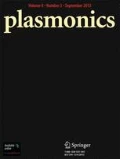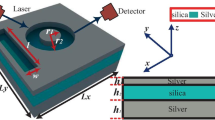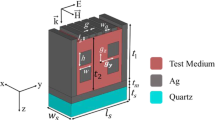Abstract
In this paper, the simultaneous switching and sensing capabilities of a compact plasmonic structure based on a conventional rectangular hole in a silver film are proposed and investigated. The proposed structure has ultrahigh sensitivity up to 3000 nm/RIU and high figure of merit of 170 RIU−1. Also, the simulation results show the potential of the presented refractive index sensor to detect malaria infection, cancer cells, bacillus bacteria, and solution of glucose in water. Simultaneously, by changing the incident lightwave polarization, the structure behaves like a plasmonic switch, which has high extinction ratios of 15.81, 31.20, and 25.03 dB at three telecommunication wavelengths of 850, 1310, and 1550 nm, respectively. The ultrafast response time of 20 fs is achieved for the wideband application of the switching capability at the wavelength range of 1056 to 1765 nm. Moreover, the equivalent circuit model and transmission (ABCD) matrix methods are derived to validate the simulated results. Simple design, good agreement between the numerical and analytical results, biomedical applications, ultrahigh sensitivity, and ultrafast performance of the proposed structure help this idea to open up paths for design and implementation of other multi-application plasmonic devices in near-infrared region. To the best of our knowledge, the mentioned analytical methods have not been studied former at near-infrared wavelengths. Therefore, the achievements could pave the way for verifying the simulation results of plasmonic nanostructures in future investigations.















Similar content being viewed by others
References
Sun T, Deng Z, Sheng J, Chen Z, Zhu W, Guo W, and Wang X (2018) A compact optical switch via plasmonics of subwavelength circular-sharp hole arrays in metal films. Ann. Phys. 530:1700299-1-6
Nurmohammadi T, Abbasian K, Yadipour R (2018) Ultra-fast all-optical plasmonic switching in near infra-red spectrum using a Kerr nonlinear ring resonator. Opt Commun 410:142–147
Wang X, Wang J, Hu Z-D, Song C, Xia X (2017) Modulating plasmonic sensor with graphene-based silicon grating. Plasmonics 12:1725–1731
Li G, Chen X, Li O, Shao C, Jiang Y, Huang L, Ni B, Hu W, Lu W (2012) A novel plasmonic resonance sensor based on an infrared perfect absorber. J Phys D Appl Phys 45:205102-1-5
Hu F, Yi H, Zhou Z (2011) Band-pass plasmonic slot filter with band selection and spectrally splitting capabilities. Opt Express 19:4848–4855
Nejat M, Nozhat N (2019) Design, theory and circuit model of wideband, tunable and polarization-insensitive terahertz absorber based on graphene. IEEE Trans Nanotech 18:684–690
Nejat M, Nozhat N (2019) Ultrasensitive THz refractive index sensor based on a controllable perfect MTM absorber. IEEE Sensors J 19:10490–10497
Chen J, Li Z, Zhang X, Xiao J, Gong Q (2013) Submicron bidirectional all-optical plasmonic switches. Sci Rep 3:1451–11-6
Ebbesen TW, Lezec HJ, Ghaemi HF, Thio T, Wolff PA (1998) Extraordinary optical transmission through sub-wavelength hole arrays. Nature 391:667–669
Orbons SM, Roberts A (2006) Resonance and extraordinary transmission in annular aperture arrays. Opt Express 14:12623–12628
Wang Y, Qin Y, Zhang Z (2014) Extraordinary optical transmission property of X-shaped plasmonic nanohole arrays. Plasmonics 9:203–207
Parsons J, Hendry E, Burrows CP, Auguié B, Sambles JR, Barnes WL (2009) Localized surface-plasmon resonances in periodic nondiffracting metallic nanoparticle and nanohole arrays. Phys Rev B 79:073412–0731-4
Rodrigo SG, Mahboub O, Degiron A, Genet C, García-Vidal FJ, Martín-Moreno L, Ebbesen TW (2010) Holes with very acute angles: a new paradigm of extraordinary optical transmission through strongly localized modes. Opt Express 18:23691–23697
Lovera P, Jones D, Corbett B, O’Riordan A (2012) Polarization tunable transmission through plasmonic arrays of elliptical nanopores. Opt Express 20:25325–25332
Friberg SR, Silberberg Y, Mk O, Andrejco MJ, Saifi MA, Smith PW (1987) Ultrafast all-optical switching in a dual-core fiber nonlinear coupler. Appl Phys Lett 51:1135–1137
Li S, Han K, Ansari N, Bao Q, Hu D, Liu J, Yu S, Zhu Z (2017) Improving SDN scalability with protocol-oblivious source routing: a system-level study. IEEE Trans Netw Serv Manag 15:275–288
Ishii K, Inoue T, Kim I, Wang X, Tan HN, Zhang Q, Ikeuchi T, Namiki S (2018) Analysis and demonstration of network utilization improvement through format-agnostic multi-channel wavelength converters. J Opt Commun Netw 10:A165–A174
Jandaghian A, Lotfalian A, Kouhkan M, Mohajerani E (2016) Performance improvement of long-range surface plasmon structure for use in an all-optical switch. Opt Eng 56:121901–1211-6
Först M, Manzoni C, Kaiser S, Tomioka Y, Tokura Y, Merlin R, Cavalleri A (2011) Nonlinear phononics as an ultrafast route to lattice control. Nat Phys 7:854–856
Kampfrath T, Sell A, Klatt G, Pashkin A, Ma¨hrlein S, Dekorsy T, Wolf M, Fiebig M, Leitenstorfer A, Huber R (2011) Coherent terahertz control of antiferromagnetic spin waves. Nat. Photonics 5:31–34
Fleischer S, Zhou Y, Field RW, Nelson KA (2011) Molecular orientation and alignment by intense single-cycle THz pulses. Phys Rev Lett 107:163603–1631-5
Wraback M, Shen H (2000) A femtosecond, polarization-sensitive optically addressed modulator based on virtual exciton effects in an anisotropically strained multiple quantum well. Appl Phys Lett 76:1288–1290
Vicario C, Ruchert C, Ardana-Lamas F, Derlet PM, Tudu B, Luning J, Hauri CP (2013) Off-resonant magnetization dynamics phase-locked to an intense phase-stable terahertz transient. Nat Photonics 7:720–723
Yang Y, Kelley K, Sachet E, Campione S, Luk TS, Maria J, Sinclair MB, Brener I (2017) Femtosecond optical polarization switching using a cadmium oxide-based perfect absorber. Nat Photonics 11:390–395
Fan Y, Zhang F, Shen N H, Fu Q, Wei Z, Li H, and Soukoulis C M (2018) Achieving a high-Q response in metamaterials by manipulating the toroidal excitations. Phys. Rev. a 97:033816-1-6
Fan Y, Shen NH, Zhang F, Zhao Q, Wei Z, Zhang P, Dong J, Fu Q, Li H, Soukoulis CM (2018) Photoexcited graphene metasurfaces: significantly enhanced and tunable magnetic resonances. ACS Photonics 5:1612–1618
Xu J, Fan Y, Yang R, Fu Q, Zhang F (2019) Realization of switchable EIT metamaterial by exploiting fluidity of liquid metal. Opt Express 27:2837–2843
Yousuf SEH, Sakib MA, Islam MZ (2018) A high-performance plasmonic nanosensor based on an elliptical nanorod in an MIM configuration. IEEE Sensors J 18:6145–6153
Zhu Y, Zhang H, Li D, Zhang Z, Zhang S, Yi J, Wang W (2018) Magnetic plasmons in a simple metallic nanogroove array for refractive index sensing. Opt Express 26:9148–9154
Babar S, Weaver JH (2015) Optical constants of Cu, Ag, and Au revisited. Appl Opt 54:477–481
Degiron A, Ebbesen TW (2005) The role of localized surface plasmon modes in the enhanced transmission of periodic subwavelength apertures. J Opt A Pure Appl Opt 7:S90–S96
Chen F, Yao D (2014) Tunable multiple all-optical switch based on multi-nanoresonator-coupled waveguide systems containing Kerr material. Opt Commun 312:143–147
Xu B, Gu C, Li Z, Niu Z (2013) A novel structure for tunable terahertz absorber based on graphene. Opt Express 21:23803–23811
Balanis CA (1999) Advanced engineering electromagnetics. John Wiley & Sons
Liu PY, Chin LK, Ser W, Chen HF, Hsieh C, Lee C, Sung K, Ayi TC, Yap PH, Liedberg B, Wang K, Bourounia T, Liprence Y (2016) Cell refractive index for cell biology and disease diagnosis: past, present and future. Lab Chip 16:634–644
Ghaemi HF, Thio T, Grupp DE, Ebbesen TW, Lezec HJ (1998) Surface plasmons enhance optical transmission through subwavelength holes. Phys Rev B 58:6779–6782
Singh M, Datta A (2018) Modeling of a vertical hybrid plasmonic switch with VO2Fin Bragg grating. IEEE Photon Technol Lett 30:997–1000
Singh M (2019) Design of hybrid multilayer plasmonic switch-cum-splitter with 90° bends. Optik 178:902–908
Sui G, Wu J, Zhang Y, Yin C, and Gao X (2018) Microcavity-integrated graphene waveguide: a reconfigurable electro-optical attenuator and switch. Sci. Rep. 8:12445-1-7
Sun X, Chen X, Yan M, Qiu M, Thylén L, Wosinski L (2016) All-optical switching using a hybrid plasmonic donut resonator with photothermal absorber. IEEE Photon Technol Lett 28:1609–1612
Joushaghani A, Kruger BA, Paradis S, Alain D, Stewart Aitchison J, Poon JK (2013) Sub-volt broadband hybrid plasmonic-vanadium dioxide switches. Appl Phys Lett 102:061101–0611-4
Yang H, Kuan Y, Xiang T, Zhu Y, Cai X, Liu L (2018) Broadband polarization-insensitive optical switch on silicon-on-insulator platform. Opt Express 26:14340–14345
Xu Y, Wu L, Ang LK (2018) MoS2-based highly sensitive near-infrared surface plasmon resonance refractive index sensor. IEEE J Selec Topics Quant Electron 25:4600307-1-7
Zafar R, Nawaz S, Singh G, d'Alessandro A, Salim M (2018) Plasmonics-based refractive index sensor for detection of hemoglobin concentration. IEEE Sensors J 18:4372–4377
Author information
Authors and Affiliations
Corresponding author
Additional information
Publisher’s Note
Springer Nature remains neutral with regard to jurisdictional claims in published maps and institutional affiliations.
Rights and permissions
About this article
Cite this article
Nejat, M., Nozhat, N. Analytical Methods of Equivalent Circuit Model and Transmission Matrix for a Plasmonic Switch with Sensing Capability in Near-Infrared Region. Plasmonics 15, 1459–1470 (2020). https://doi.org/10.1007/s11468-020-01167-x
Received:
Accepted:
Published:
Issue Date:
DOI: https://doi.org/10.1007/s11468-020-01167-x




